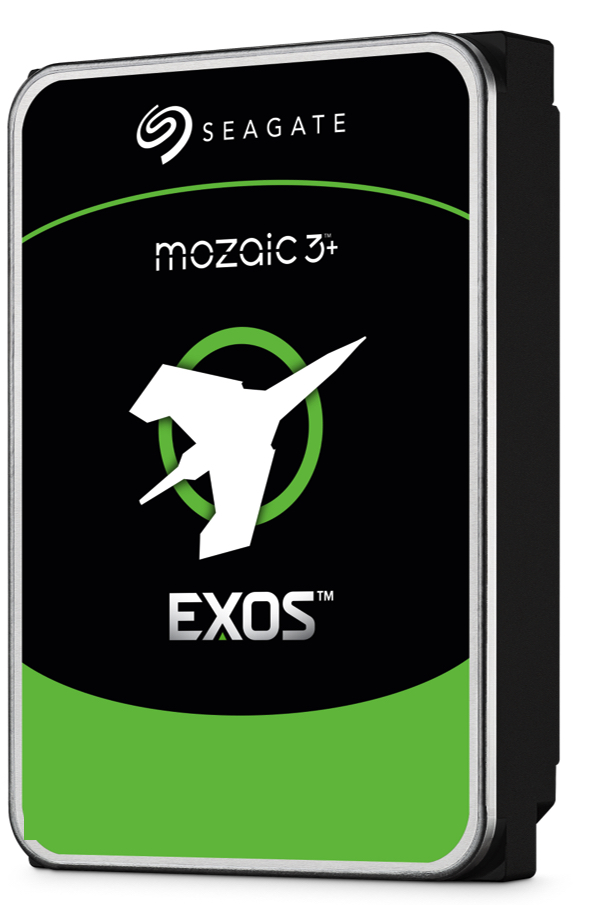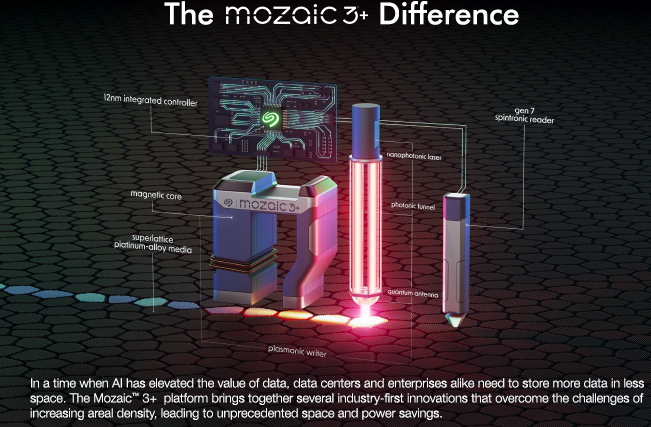Seagate Mozaic 3+, WW Highest Capacity HDD at 30TB and Shipping in 1Q24
40TB and 50TB next steps also with 10 disks and HAMR
This is a Press Release edited by StorageNewsletter.com on January 18, 2024 at 2:02 pmSeagate Technology Holdings plc launched the Mozaic 3+ HDD platform – which incorporates its implementation of HAMR technology.

The launch heralds areal densities of 3TB+ per platter – and a roadmap that will achieve 4TB+ and 5TB+ per platter in the coming years.
The platform powers firm’s Exos product family, with newly announced, industry-leading capacity points of 30TB and beyond.
Exos 30TB+ products are shipping in volume this quarter to hyperscale cloud customers.
Company’s areal density innovation – which increases the number of bits that can be stored on a platter – addresses common industry pain points. Mozaic 3+ enables customers to store more data in the same floor space than ever before. Upgrading from a 16TB conventional PMR drive (the average capacity in large-scale data centers) to an Exos 30TB Mozaic 3+ technology drive effectively doubles capacity in the same footprint.
The platform uses roughly the same material components as PMR HDDs while increasing capacity, allowing data centers to lower storage acquisition and operational costs – including a 40% improvement in per terabyte power consumption. Mozaic 3+ can also help customers achieve sustainability goals – a priority for large-scale data centers – by offering a 55% reduction in embodied carbon per terabyte (when comparing a 30TB Mozaic 3+ drive with a traditional 16TB PMR drive).
The manufacturer is experiencing strong demand from data center customers that are expected to complete qualification of Mozaic 3+ and move into volume ramp by end of this quarter. A leading cloud service provider is focused on shifting the majority of Seagate-provided drives to Mozaic 3+, reflecting its confidence in the technology.
“Seagate is the world’s only HDD manufacturer with the areal density capability to get to 3TB per platter and with 5TB on the horizon,” said Dave Mosley, CEO. “As AI use cases put a premium on raw data sets, more companies are going to need to store all the data they can. To accommodate the resulting masses of data, areal density matters more than ever.“
“The Mozaic 3+ platform represents more than just HAMR technology,” he noted. “It comprises several industry-first innovations that we’ve integrated to help us scale areal density.”
Few highlights:
1. Superlattice Platinum-Alloy Media. Fundamental physics of higher-density recording requires smaller media grain size at nanoscale. The challenge here is that smaller grains are more unstable. Legacy alloys do not provide sufficient magnetic stability for effective and reliable storage. In Mozaic 3+ HDDs, the media alloy uses a pioneering iron-platinum superlattice structure, which significantly increases the magnetic coercivity of disk media. This allows for precise data writing and bit stability.
2. Plasmonic Writer. Since the media are made magnetically “harder” to prevent instability, the design requires a revolutionary writer – a marvel of miniaturization and precision engineering that is Seagate’s unique implementation of HAMR. Anchoring this technology is a nanophotonic laser, which produces an infinitesimal heat spot on the media surface to reliably write the data.
Also today, the company announced plans to vertically integrate the nanophotonic laser into the plasmonic writer sub-system.
“Developing this unique laser technology in-house for Mozaic 3+ will ensure even greater efficiency and yield to support rapid scaling of volume production,” Mosley said.
3. Gen 7 Spintronic Reader. Smaller grains of written data are only useful if they can be read. Integrated along with the sub-components of the plasmonic writer, the reader also needed to evolve. Incorporating quantum technology, Mozaic 3+ includes one of the world’s smallest and most sensitive magnetic field reading sensors.
4. 12nm Integrated Controller. Efficiently orchestrating all this technology called for an integrated controller, a SoC, developed entirely in house. This sophisticated application-specific IC delivers up to 3x the performance compared to prior solutions.
“HDD areal density improvements are critical for economically and efficiently expanding the installed base of HDD-based mass storage, especially in data centers,” said John Rydning, research VP, IDC global DataSphere. “Seagate’s innovative areal density breakthrough is timely and will enable it to deliver increasingly higher capacity HDD products for many years.”
In addition to data centers, Mozaic 3+ storage technology will enable a range of use cases, ranging from enterprise, to edge, NAS, and video and imaging applications (VIA) markets.
Comments
The 3.5-inch form factor for HDD was originally invented by Scottish Rodime in 1983 with a capacity of 10MB, and Seagate was obliged to pays as much as $45 million to Rodime for patent infringement in 2022.
Now it's 3,000x more in the same volume and these units represent the bulk of the current HDD market, especially for high capacities, the only segment going up in a decreasing global market seriously attacked by SSDs, even if "price of SSDs is 5 to 1 more than HDDs", told us Dr. John Morris, SVP and CTO at Seagate.
You have 2 possibilities to increase current capacities of HDDs:
1/ Add 1 or 2 more disks into the drive, "which is possible", said Morris, but it needs additional heads and electronics and generates higher acquisition cost, power consumption and embodied carbon
2/ Increase the areal density of each disk platter
Here Seagate has chosen this latter for its next 3 gens of drives and then, after that, will opt for the first one in the future.
Here is the technology used by Seagate to add more bits on its magnetic platters (3TB per disk), especially with nanophotonic laser, photonic tunnel and quantum antenna:
Mosaic 3+ difference
Click to enlarge

Qualifications of the 30TB device are expected to complete and move into volume ramp by this March.
Next step for nearline units will be 40TB then 50TB, once more with HAMR, 10 disks, and increasing areal density to reach 4TB and 5TB/disk, to be released between 2025 and 2026 and between 2027 and 2028 respectively.
Seagate has not revealed neither the complete specs of the Mozaic 3+ nor its price. On Amazon, you can find the Seagate Exos X24 3.5" HDD 24TB 7,200rpm SATA 6Gb/s at €557, and the WD Ultrastar DC HC580 24TB at €561. So the new Seagate unit will be a little more expansive.
Per comparison, the SSD Samsung PM1643a 2.5" 12Gb SAS at 15.36TB costs €2,248 at Amazon.
Toshiba and WD, the 2 only competitors of Seagate, will probably have in more or less time HDDs with this same 30TB capacity, as all these companies exchange their IP technology.














 Subscribe to our free daily newsletter
Subscribe to our free daily newsletter


